May 20, 2025 | 08:23 GMT +7
May 20, 2025 | 08:23 GMT +7
Hotline: 0913.378.918
May 20, 2025 | 08:23 GMT +7
Hotline: 0913.378.918
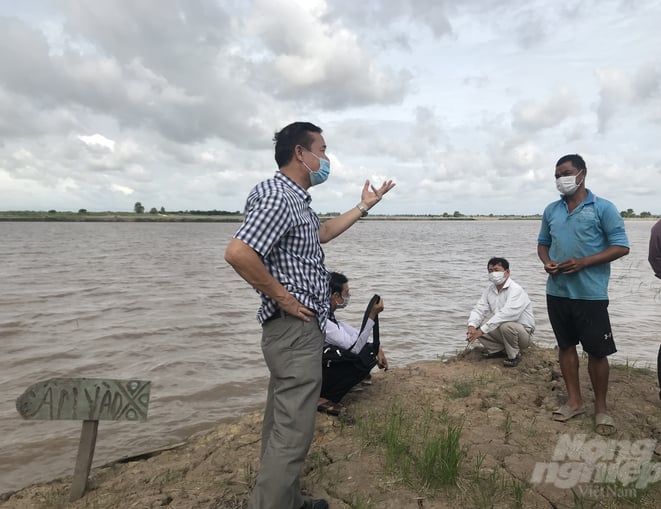
The sub-project sub-project on "Improving flood drainage capacity and developing sustainable, climate-adaptive livelihoods for the Dong Thap Muoi region, under the ICRSL Project", has been approved by Dong Thap Provincial People's Committee starting from October 2018. Photo: Trong Linh.
Mr. Vo Thanh Ngoan, Deputy Director of Dong Thap Provincial Department of Agriculture and Rural Development and Director of Dong Thap ICRSL Sub-Project Management Board, stated that: The sub-project on "Improving flood drainage capacity and developing sustainable, climate-adaptive livelihoods for the Dong Thap Muoi region, under the ICRSL Project" has been approved by Dong Thap Provincial People's Committee starting from October 2018.
Accordingly, the sub-project will be implemented in 4 districts and cities on a total area of 115 hectares, including: Hong Ngu, Tam Nong, Thanh Binh districts and Hong Ngu city, with 12 models and 5 frameworks of livelihoods. Namely, these works include 8 models of two rice crops - one fish crop; the remaining are two rice crops - one shrimp crop model, two rice and duck crops - one fish crop model, two rice crop - one fish model and rice crop – shrimp/fish crop model.
Mr. Vo Thanh Ngoan commented on the effectiveness of each model: For the model of two rice crops - one fish crop, the average total profit reached over 57 million dong per hectare every year. Namely, the rice production yielded a profit of over 52 million dong/hectare and fish production yielded 5 million dong/hectare.
According to Mr. Ngoan, comparatively speaking, the total profit from the model increased by 15.4 million VND/hectare/year. Most notably, the profit from rice production increased by 10.4 million VND/hectare due to the application of technical measures, reduced costs for inputs, seed production, output consumption links and so on.
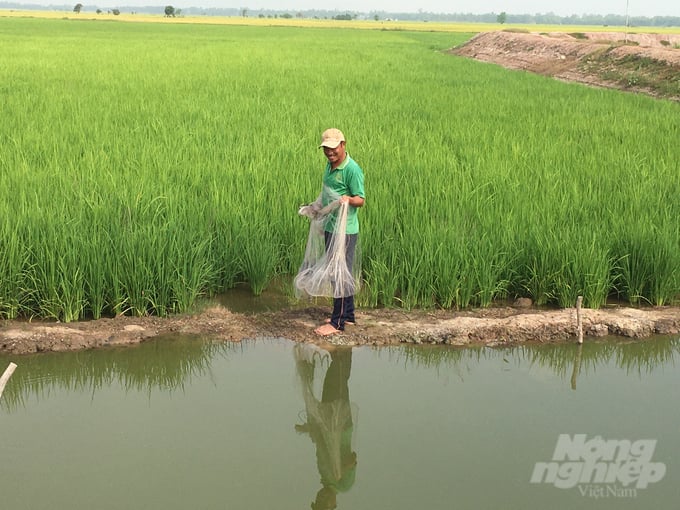
For the model of two rice crops - one fish crop, the average total profit reached over 57 million dong per hectare every year. Namely, the rice production yielded a profit of over 52 million dong/hectare and fish production yielded 5 million dong/hectare. Photo: Trong Linh.
The two rice crops - one fish crop model is considered to have brought high efficiency in fishing activities during the flood season in Binh Hoa Ha hamlet, Thuong Lac commune, Hong Ngu district, Dong Thap province. The total profit of the model reached 53.4 million VND/hectare, whereas the profit from fish farming and fishing was 21.5 million VND/hectare/year. The total profit increased by 22.7 million VND/hectare compared to outside the model.
This model with implemented with relatively favorable conditions including watershed area, low terrain, flood water arrives earlier compared to other models, an abundant source of natural fish. Most importantly, farmers have a large investment capital; they actively research the selling price, potential output consumption, nurture and release fingerlings early, set up nets to lure natural fish in time with the rising floods. In addition, there is a system of ditches around the field to contain the fish until they reach a desired weight and farmers harvest when the selling price is high.
The two rice and duck crops - one fish crop model was observed to have given the best effect in the sub-project models. Total profit from the model reached over 100 million VND/hectare/year, which is an increase of more than 52 million VND/ha compared to outside the model. Profit from the two rice crops reached over 61 million VND/hectare/year, profit from the duck crop reached 21.5 million VND/hectare/year, and profit from the fish crop reached nearly 12 million VND/hectare/year.
According to Mr. Ngoan, thanks to the combination of duck farming and fish stocking in rice fields, the production costs for all three targets are reduced. During the flood season, farners raise laying ducksusing the barn and natural food, plant and harvest poplar around the field in addition to raising and baiting fish, which contributed to increasing income per unit area as a result.
"This is a model with gradual investment based on capital and technical capabilities, with special focus on the arrangement of continuous production, the positive spirit and the hard work of the farmers."
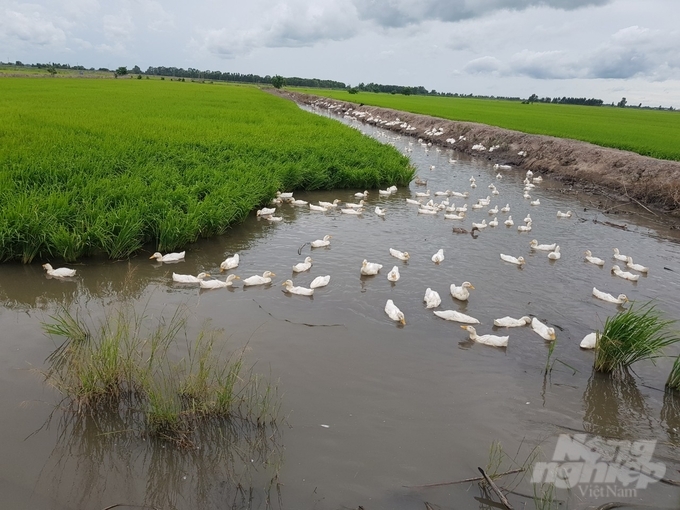
The two rice and duck crops - one fish crop model yielded extremely positive effects among the sub-project models. Photo: Trong Linh.
Deputy Director of the Department of Agriculture and Rural Development of Dong Thap province commented on the two rice crops - one shrimp crop model: Farmers has been proactive in raising and nurturing seed early, reducing the density of seed, preparing facilities and backup pond thoroughly. However, the flood water is too late and low so the shrimps cannot be released into the field; leading to the slow growth of shrimps raised in ponds, increased costs due to increased feed, water pumping, oxygen. Consequently, the output and the selling price is low, so profits from shrimp is estimated at only 291,000 VND/hectare. The total profit from the model reached over 60 million VND/hectare/year, which is 51.6 million VND/hectare/year higher compared to outside the model. The main profit from rice production is estimated at approximately 60 million VND/hectare/year.
Total profit from the two rice crop - one fish model is 135 million VND/hectare/year, an increase of 35.8 million VND/hectare/year compared to the outside model. This is the model with the highest profit among the 5 models, but the profit margin is only 56%, lower than the other models due to high investment costs.
The model has a pretty well-maintained system of ponds and ditches for raising fish, but the field surface is high, the flood water level is low, so it is only possible to release fish in ponds instead of the fields. Because the anabas farming model has a short farming time and the investment cost for feed is low, there is still profit from additional fish farming, but the profit only reached nearly 380 thousand VND/hectare.
However, the stocking of wild fish is relatively profitable (at 3 million VND/hectare), so the total profit from fish farming in the model is 3.3 million VND/hectare/year.
The rice crop – shrimp/fish crop model has been implemented since the end of May 2021. Because this is a pilot model of the first production crop, coupled with the high costs for infrastructure investment, treatment and rehabilitation of ponds and ditches surrounding the field increased, as well as the low yield of summer rice due to the trial of 3 varieties to select suitable rice varieties for production conditions, the total profit from the model is only 30.1 million VND/hectare/crop, much lower compared to the model's potentials.
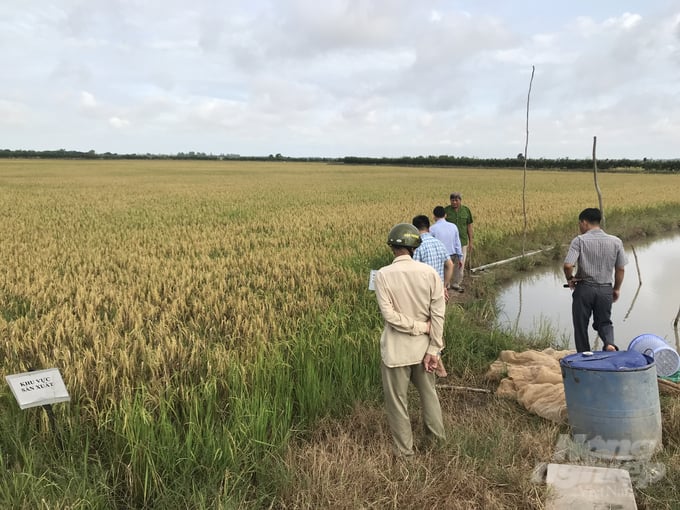
The models within the project have yielded high profits due to the reduction in the amount of seeds, chemical fertilizers, and pesticides. Photo: Trong Linh.
Mr. Vo Thanh Ngoan assessed: Models in the project have higher profits compared to non-project models due to a decrease in the amount of seeds, chemical fertilizers, and pesticides. Some models are starting to link safe rice consumption with businesses, which is the basis to encourage and mobilize surrounding farmers to implement in order to improve production efficiency, ensuring health, environment protection as well as better land and water management.
According to Mr. Ngoan, the two rice crops -one fish crop model is the most popular in the project area because it is relatively easy to implement, with the basic production of two rice crops applying technical advances to improve quality, ensure food safety, and earn VietGAP certification to link consumption and improve efficiency. Depending on field conditions and available infrastructure, farmers can raise or store wild fish in the flood season to earn extra income, facilitating the management of floods according to the project's objectives.
The two rice crops - one fish crop model is suitable for saving water, with the ability to give higher profits compared to rice production, but the profit rate is low (56%) so it requires high capital investment. In addition, it is necessary to be flexible in selecting plants suitable to soil conditions and markets, good consumption linkages, and efficiently apply technical solutions to production.
More importantly, the model needs abundant human resources in the care and harvesting stages, so this can create more employment opportunities and income for idle workers, ensuring stability and social security.
In the rice crop - shrimp/fish crop model, wild fish can bring high economic efficiency. The product is created in an organic direction, ensuring food safety, hygiene, environmentally friendliness as well as adaptation to the current climate change conditions. On the other hand, this model contributes to creating and maintaining key regional products, creating a new direction for economic development in the flood season. However, it requires considerable investment in infrastructure as well as flexibility in market access and consumption linkages.
Translated by Nguyen Hai Long
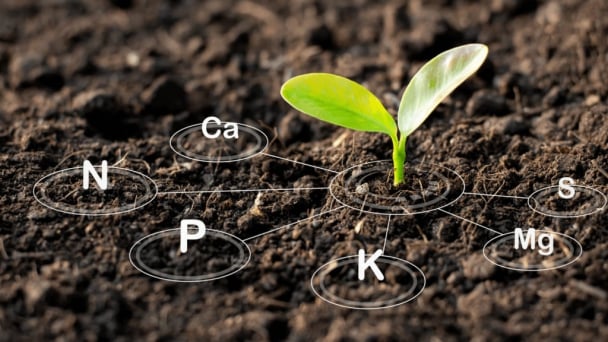
(VAN) Vietnam aims to become a 'leader' in the region in the capacity and managing effectively soil health and crop nutrition.
![Reducing emissions from rice fields: [Part 1] Farming clean rice together](https://t.ex-cdn.com/nongnghiepmoitruong.vn/608w/files/news/2025/05/05/z6509661417740_a647202949c539012a959e841c03e1d3-nongnghiep-143611.jpg)
(VAN) Growing clean rice helps reduce environmental pollution while increasing income, allowing farmers to feel secure in production and remain committed to their fields for the long term.
/2025/05/19/5136-1-144800_230.jpg)
(VAN) The Nghe An Provincial People's Committee has just approved the list of beneficiaries eligible for revenue from the Emission Reductions Payment Agreement (ERPA) in the North Central region for the year 2025.
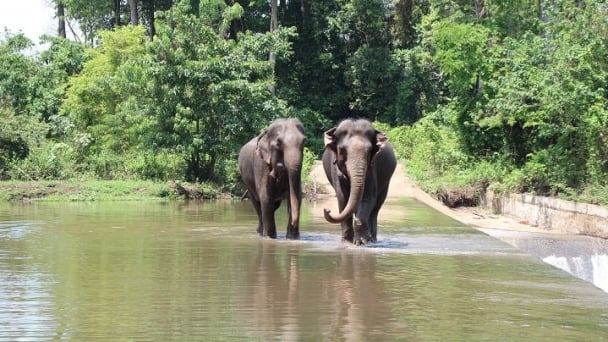
(VAN) 14 out of 35 domesticated elephants in Dak Lak province have had their living conditions improved, with 11 of them currently participating in the non-riding elephant tourism model.

(VAN) Muong Nhe Nature Reserve hopes that being upgraded to a national park will lay the foundation for forest protection efforts to be carried out in a systematic, modern, and sustainable manner.
/2025/05/16/3923-2-171845_52.jpg)
(VAN) Lower costs, higher yields, and improved soil quality are outstanding benefits that soybeans bring when integrated into the crop rotation system.
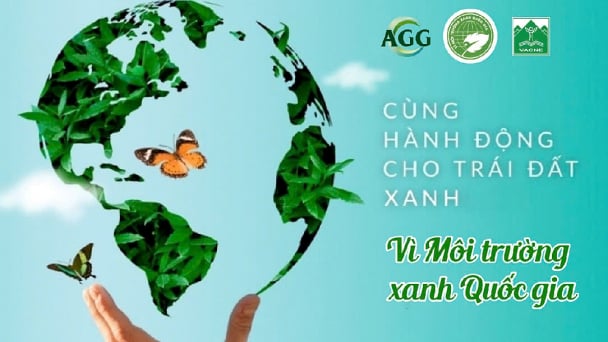
(VAN) The 'For a Green National Environment' programme aims to promote a green lifestyle, support businesses in implementing ESG practices, and turn Net Zero commitments into concrete actions.